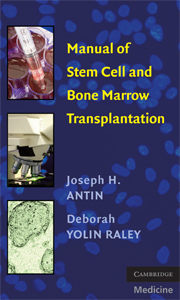Book contents
- Frontmatter
- Contents
- Acknowledgments
- Manual of Stem Cell and Bone Marrow Transplantation
- 1 Rationale for Transplantation
- 2 Types of Transplantation
- 3 HLA Matching in Allogeneic Transplantation
- 4 Stem Cell Source
- 5 Pretransplant Evaluation and Counseling of Patient and Donor
- 6 Conditioning Regimens
- 7 Stem Cell Infusion
- 8 ABO Compatibility
- 9 Engraftment
- 10 Preventative Care
- 11 Transplant-Related Complications
- 12 Graft-Versus-Host Disease – Prophylaxis and Acute
- 13 Graft-Versus-Host Disease – Chronic
- 14 Engraftment Syndrome
- 15 Infectious Disease
- 16 Graft Rejection And Failure
- 17 Gastrointestinal Complications
- 18 Pulmonary Complications
- 19 Veno-Occlusive Disease
- 20 Special Transfusion-Related Situations
- 21 Cardiovascular Complications
- 22 Neurologic Complications
- 23 Cystitis
- 24 Donor Lymphocyte Infusion
- 25 Transplantation: Regulation And Accreditation
- Appendix
- Index
21 - Cardiovascular Complications
Published online by Cambridge University Press: 23 November 2009
- Frontmatter
- Contents
- Acknowledgments
- Manual of Stem Cell and Bone Marrow Transplantation
- 1 Rationale for Transplantation
- 2 Types of Transplantation
- 3 HLA Matching in Allogeneic Transplantation
- 4 Stem Cell Source
- 5 Pretransplant Evaluation and Counseling of Patient and Donor
- 6 Conditioning Regimens
- 7 Stem Cell Infusion
- 8 ABO Compatibility
- 9 Engraftment
- 10 Preventative Care
- 11 Transplant-Related Complications
- 12 Graft-Versus-Host Disease – Prophylaxis and Acute
- 13 Graft-Versus-Host Disease – Chronic
- 14 Engraftment Syndrome
- 15 Infectious Disease
- 16 Graft Rejection And Failure
- 17 Gastrointestinal Complications
- 18 Pulmonary Complications
- 19 Veno-Occlusive Disease
- 20 Special Transfusion-Related Situations
- 21 Cardiovascular Complications
- 22 Neurologic Complications
- 23 Cystitis
- 24 Donor Lymphocyte Infusion
- 25 Transplantation: Regulation And Accreditation
- Appendix
- Index
Summary
MYOPERICARDITIS
Cyclophosphamide cardiotoxicity is idiosyncratic and independent of baseline cardiac function. When used in high doses, cyclophosphamide can induce myopericarditis that can be associated with pericardial tamponade or pulseless electrical activity (PEA) arrest and death. Milder forms may lead to congestive heart failure, requiring appropriate therapy. More common is the development of myocardial edema that can result in reduction in electrocardiogram (ECG) voltage but no functional consequences.
Clinical Manifestations
Shortness of breath, chest discomfort (often pleuritic and improved with sitting up), cough, fever, tachycardia.
Diagnosis
Pericardial rub, ST segment elevation, PR depression.
Echocardiogram may show fluid; with impending tamponade, may also have diastolic indentation or collapse of the right ventricle. Aspiration under fluoroscopic guidance may be required for presumed infectious or malignant etiologies.
Treatment
If manifestations are mild, supportive care is usually adequate.
Nonsteroidal anti-inflammatory drugs (NSAIDS) are not used in patients with thrombocytopenia.
If cyclophosphamide is the presumed etiology, there is no specific therapy.
If the underlying problem is infectious or malignant it is treated specifically.
Pericardiocentesis or a pericardial window if tamponade develops.
ARRHYTHMIAS AND CONDUCTION ABNORMALITIES
Arrhythmias are uncommon during hematopoietic stem cell transplantation (HSCT) except as reflections of preexistent heart disease. New onset rhythm disturbances or conduction delay may be due to dimethyl sulfoxide (DMSO) at the time of stem cell infusion, cyclophosphamide, volume overload, infection, medications, infarction, cardiomyopathy, pulmonary embolus, electrolyte abnormalities, and thyroid disease.
- Type
- Chapter
- Information
- Manual of Stem Cell and Bone Marrow Transplantation , pp. 147 - 149Publisher: Cambridge University PressPrint publication year: 2009



